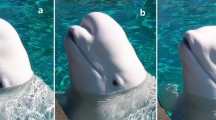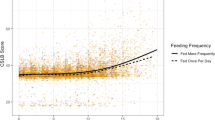Abstract
Dogs’ special relationship with humans not only makes them ubiquitous in our lives, but working dogs specifically perform essential functions for us such as sniffing out bombs and pulling wheelchairs for the disabled. To enhance the performance of working dogs, it is essential to understand the cognitive skills that underlie and lead to their success. This review details recent work in the field of canine cognition, including how dogs have evolved socio-cognitive skills that mimic or, in some cases, rival even our closest primate relatives. We review how these findings have laid the foundation for new studies that hope to help enhance working dog programs. This includes work that has begun to reveal the development and stability of the most important traits for service work. Discoveries like these suggest the possibility of translating what we have learned to improve breeding, selection, and training for these jobs. The latest research we review here shows promise in contributing to the production of better dogs and, consequently, more help for people.
Similar content being viewed by others
References
Agnetta B, Hare B, Tomasello M (2000) Cues to food locations that domestic dogs (Canis familiaris) of different ages do and do not use. Anim Cogn 3:107–112
Albuquerque N, Guo K, Wilkinson A, Savalli C, Otta E, Mills D (2016) Dogs recognize dog and human emotions. Biol Lett 12(1):20150883
Bhattacharjee D, Mandal S, Shit P, Varghese MG, Vishnoi A, Bhadra A (2020) Free-ranging dogs are capable of utilizing complex human pointing cues. Front Psychol 10:2818
Bray E, MacLean E, Hare B (2014) Context-specificity of inhibitory control in dogs. Anim Cogn 17:15–31
Bray E, MacLean E, Hare B (2015) Increasing arousal enhances inhibitory control in calm but not excitable dogs. Anim Cogn 18:1–13
Bray EE, Gruen ME, Gnanadesikan GE, Horschler DJ, Levy KM, Kennedy BS, Hare BA, MacLean EL (2020a) Dog cognitive development: a longitudinal study across the first 2 years of life. Anim Cogn. https://doi.org/10.1007/s10071-020-01443-7
Bray EE, Gruen ME, Gnanadesikan GE, Horschler DJ, Levy KM, Kennedy BS, Hare BA, MacLean EL (2020b) Cognitive characteristics of 8-to 10-week-old assistance dog puppies. Anim Behav 166:193–206
Call J, Bräuer J, Kaminski J, Tomasello M (2003) Domestic dogs (Canis familiaris) are sensitive to the attentional state of humans. J Comp Psychol 117(3):257
Carpenter M, Nagell K, Tomasello M, Butterworth G, Moore C (1998) Social cognition, joint attention, and communicative competence from 9 to 15 months of age. Monogr Soc Res Child Dev 63(4):i
Custance D, Mayer J (2012) Empathic-like responding by domestic dogs (Canis familiaris) to distress in humans: an exploratory study. Anim Cogn 15(5):851–859. https://doi.org/10.1007/s10071-012-0510-1
Deputte BL, Doll A (2011) Do dogs understand human facial expressions? J Vet Behav Clin Appl Res 6(1):78–79. https://doi.org/10.1016/j.jveb.2010.09.013
Fugazza C, Pogány Á, Miklósi Á (2020) Depths and limits of spontaneous categorization in a family dog. Sci Rep. https://doi.org/10.1016/j.cub.2016.09.057
Gácsi M, Gyoöri B, Virányi Z, Kubinyi E, Range F, Belényi B, Miklósi Á (2009) Explaining dog wolf differences in utilizing human pointing gestures: selection for synergistic shifts in the development of some social skills. PLoS One 4(8):e6584
Gnanadesikan GE, Hare B, Snyder-Mackler N, MacLean EL (2020a) Estimating the heritability of cognitive traits across dog breeds reveals highly heritable inhibitory control and communication factors. Anim Cogn 23(5):953–964
Gnanadesikan GE, Hare B, Snyder-Mackler N, Call J, Kaminski J, Miklósi Á, MacLean EL (2020b) Breed differences in dog cognition associated with brain-expressed genes and neurological functions. Integr Comp Biol 60(4):976–990
Hare B, Tomasello M (1999) Domestic dogs (Canis familiaris) use human and conspecific social cues to locate hidden food. J Comp Psychol 113:1–5
Hare B, Tomasello M (2005) Human-like social skills in dogs? Trends Cogn Sci 9:439–444
Hare B, Woods V (2013) The genius of dogs: how dogs are smarter than you think. Penguin
Hare B, Call J, Tomasello M (1998) Communication of food location between human and dog (Canis familiaris). Evol Commun 2:137–159
Hare B, Call J, Tomasello M (2001) Do chimpanzees know what conspecifics know? Anim Behav 61(1):139–151
Hare B, Brown M, Williamson C, Tomasello M (2002) The domestication of social cognition in dogs. Science 298:1636–1639
Hare B, Plyusnina I, Iganacio N, Wrangham R, Trut L (2005) Social cognitive evolution in captive foxes is a correlated by-product of experimental domestication. Curr Biol 16:226–230
Hecht EE, Smaers JB, Dunn WD, Kent M, Preuss TM, Gutman DA (2019) Significant neuroanatomical variation among domestic dog breeds. J Neurosci 39(39):7748–7758. https://doi.org/10.1523/jneurosci.0303-19.2019
Hernádi A, Kis A, Turcsán B, Topál J (2012) Man’s underground best friend: domestic ferrets, unlike the wild forms, show evidence of dog-like social-cognitive skills. PLoS ONE 7(8):e43267
Herrmann E, Call J, Hernández-Lloreda MV, Hare B, Tomasello M (2007) Humans have evolved specialized skills of social cognition: the cultural intelligence hypothesis. Science 317(5843):1360–1366
Herrmann E, Hernández-Lloreda MV, Call J, Hare B, Tomasello M (2010) The structure of individual differences in the cognitive abilities of children and chimpanzees. Psychol Sci 21(1):102–110
Horschler DJ, Hare B, Call J, Kaminski J, Miklósi Á, MacLean EL (2019) Absolute brain size predicts dog breed differences in executive function. Anim Cogn 22(2):187–198
Kaminski J, Call J, Fischer J (2004) Word learning in a domestic dog: evidence for “fast mapping”. Science 304(5677):1682–1683
Kaminski J, Hynds J, Morris P, Waller BM (2017) Human attention affects facial expressions in domestic dogs. Sci Rep 7(1):12914. https://doi.org/10.1038/s41598-017-12781-x
Kaminski J, Waller BM, Diogo R, Hartstone-Rose A, Burrows AM (2019) Evolution of facial muscle anatomy in dogs. Proc Natl Acad Sci 116(29):14677–14681. https://doi.org/10.1073/pnas.1820653116
Kis A, Topál J, Gácsi M, Range F, Huber L, Miklósi Á, Virányi Z (2012) Does the A-not-B error in adult pet dogs indicate sensitivity to human communication? Anim Cogn 15(4):737–743
Kupán K, Miklósi Á, Gergely G, Topál J (2011) Why do dogs (Canis familiaris) select the empty container in an observational learning task? Anim Cogn 14(2):259–268
Lampe M, Bräuer J, Kaminski J, Virányi Z (2017) The effects of domestication and ontogeny on cognition in dogs and wolves. Sci Rep 7(1):1–8
Lazarowski L, Haney PS, Brock J, Fischer T, Rogers B, Angle C, Katz JS, Waggoner LP (2018) Investigation of the behavioral characteristics of dogs purpose-bred and prepared to perform Vapor Wake® detection of person-borne explosives. Front Vet Sci 5:50. https://doi.org/10.3389/fvets.2018.00050
Lazarowski L, Strassberg LR, Waggoner LP, Katz JS (2019) Persistence and human-directed behavior in detection dogs: ontogenetic development and relationships to working dog success. Appl Anim Behav Sci 220:104860
Lazarowski L, Krichbaum S, Waggoner LP, Katz JS (2020) The development of problem-solving abilities in a population of candidate detection dogs (Canis familiaris). Anim Cogn 23:1–14
MacLean E, Krupenye C, Hare B (2014) Dogs account for body orientation but not visual barriers when responding to pointing gestures. J Comp Psychol 128:285
MacLean E, Herrmann E, Suchindran S, Hare B (2017) Individual differences in cooperative-communicative skills are more similar between dogs and humans than chimpanzees. Anim Behav 126:41–51
MacLean EL, Snyder-Mackler N, VonHoldt BM, Serpell JA (2019) Highly heritable and functionally relevant breed differences in dog behaviour. Proc R Soc B 286(1912):20190716
Maclean E, Hare B (2018) Enhanced selection of assistance and explosive detection dogs using cognitive measures. Front Vet Sci 5:236
Miklösi Á, Polgárdi R, Topál J, Csányi V (1998) Use of experimenter-given cues in dogs. Anim Cogn 1(2):113–121. https://doi.org/10.1007/s100710050016
Miklósi Á, Kubinyi E, Topál J, Gácsi M, Virányi Z, Csányi V (2003) A simple reason for a big difference: wolves do not look back at humans, but dogs do. Curr Biol 13(9):763–766
Morisaki A, Takaoka A, Fujita K (2009) Are dogs sensitive to the emotional state of humans? J Vet Behav Clin Appl Res 2(4):49
Nagasawa M, Murai K, Mogi K, Kikusui T (2011) Dogs can discriminate human smiling faces from blank expressions. Anim Cogn 14(4):525–533. https://doi.org/10.1007/s10071-011-0386-5
Otto CM, Cobb ML, Wilsson E (2019) Editorial: working dogs: form and function. Front Vet Sci 6:351. https://doi.org/10.3389/fvets.2019.00351
Pilley JW, Reid AK (2011) Border collie comprehends object names as verbal referents. Behav Proc 86(2):184–195
Pongrácz P, Miklósi Á, Kubinyi E, Gurobi K, Topál J, Csányi V (2001) Social learning in dogs: the effect of a human demonstrator on the performance of dogs in a detour task. Anim Behav 62(6):1109–1117
Riedel J, Schumann K, Kaminski J, Call J, Tomasello M (2008) The early ontogeny of human–dog communication. Anim Behav 75(3):1003–1014. https://doi.org/10.1016/j.anbehav.2007.08.010
Romero T, Nagasawa M, Mogi K, Hasegawa T, Kikusui T (2014) Oxytocin promotes social bonding in dogs. Proc Natl Acad Sci 111(25):9085–9090
Rossano F, Nitzschner M, Tomasello M (2014) Domestic dogs and puppies can use human voice direction referentially. Proc R Soc B Biol Sci 281(1785):20133201
Salomons H, Smith K, Callahan-Beckel M, Callahan M, Brey E, Levy K, Kennedy B, Gnanadesikan G, Horschler D, Gruen M, Tan J, MacLean E, Hare B (2021) Cooperative communication with humans evolved to emerge early in dogs. BioRxiv. https://doi.org/10.1101/2021.01.12.425620
Slabbert JM, Rasa OAE (1997) Observational learning of an acquired maternal behaviour pattern by working dog pups: an alternative training method? Appl Anim Behav Sci 53(4):309–316
Smith BP, Litchfield CA (2010) Dingoes (Canis dingo) can use human social cues to locate hidden food. Anim Cogn 13(2):367–376
Soproni K, Miklósi Á, Topál J, Csányi V (2001) Comprehension of human communicative signs in pet dogs (Canis familiaris). J Comp Psychol 115(2):122
Stewart L, MacLean EL, Ivy D, Woods V, Cohen E, Rodriguez K, McIntyre M, Mukherjee S, Call J, Kaminski J, Miklósi A, Wrangham RW, Hare B (2015) Citizen science as a new tool in dog cognition research. PloS One 10(9):e0135176
Szetei V, Miklósi Á, Topál J, Csányi V (2003) When dogs seem to lose their nose: an investigation on the use of visual and olfactory cues in communicative context between dog and owner. Appl Anim Behav Sci 83(2):141–152. https://doi.org/10.1016/S0168-1591(03)00114-X
Tomasello M, Farrar MJ (1986) Joint attention and early language. Child Develop. Retrieved December 10, 2021, from https://www.jstor.org/stable/1130423
Tomasello M, Carpenter M, Liszkowski U (2007) A new look at infant pointing. Child Dev 78(3):705–722. https://doi.org/10.1111/j.1467-8624.2007.01025.x
Topál J, Byrne RW, Miklósi A, Csányi V (2006) Reproducing human actions and action sequences: “do as I do!” in a dog. Anim Cogn 9(4):355–367
Topál J, Gergely G, Erdőhegyi Á, Csibra G, Miklósi Á (2009) Differential sensitivity to human communication in dogs, wolves, and human infants. Science 325(5945):1269–1272
Udell MA, Spencer JM, Dorey NR, Wynne CD (2012) Human-socialized wolves follow diverse human gestures… and they may not be alone. Int J Comp Psychol 25(2)
Virányi Z, Gácsi M, Kubinyi E, Topál J, Belényi B, Ujfalussy D, Miklósi Á (2008) Comprehension of human pointing gestures in young human-reared wolves (Canis lupus) and dogs (Canis familiaris). Anim Cogn 11(3):373
Waller BM, Peirce K, Caeiro CC, Scheider L, Burrows AM, McCune S, Kaminski J (2013) Paedomorphic facial expressions give dogs a selective advantage. PLoS ONE 8(12):e82686
Wobber V, Hare B (2009) Testing the social dog hypothesis: are dogs also more skilled than chimpanzees in non-communicative social tasks? Behav Process 81:423–428
Wobber V, Koler-Matznick J, Hare B, Wrangham R, Tomasello M (2009) Breed differences in domestic dogs’ comprehension of human communicative signals. Interact Stud 10:206–224
Wobber V, Herrmann E, Hare B, Wrangham R, Tomasello M (2014) Differences in the early cognitive development of children and great apes. Dev Psychobiol 56(3):547–573
Acknowledgements
Thank you to Jeff Katz and Debbie Kelly for inviting our submission. This work was funded in part by grants from the Office of Naval Research (N00014-16-12682) and the Eunice Kennedy Shriver National Institute of Child Health and Human Development (NIH-1Ro1HD097732).
Author information
Authors and Affiliations
Corresponding author
Additional information
Publisher's Note
Springer Nature remains neutral with regard to jurisdictional claims in published maps and institutional affiliations.
Rights and permissions
About this article
Cite this article
Hare, B., Ferrans, M. Is cognition the secret to working dog success?. Anim Cogn 24, 231–237 (2021). https://doi.org/10.1007/s10071-021-01491-7
Received:
Revised:
Accepted:
Published:
Issue Date:
DOI: https://doi.org/10.1007/s10071-021-01491-7




